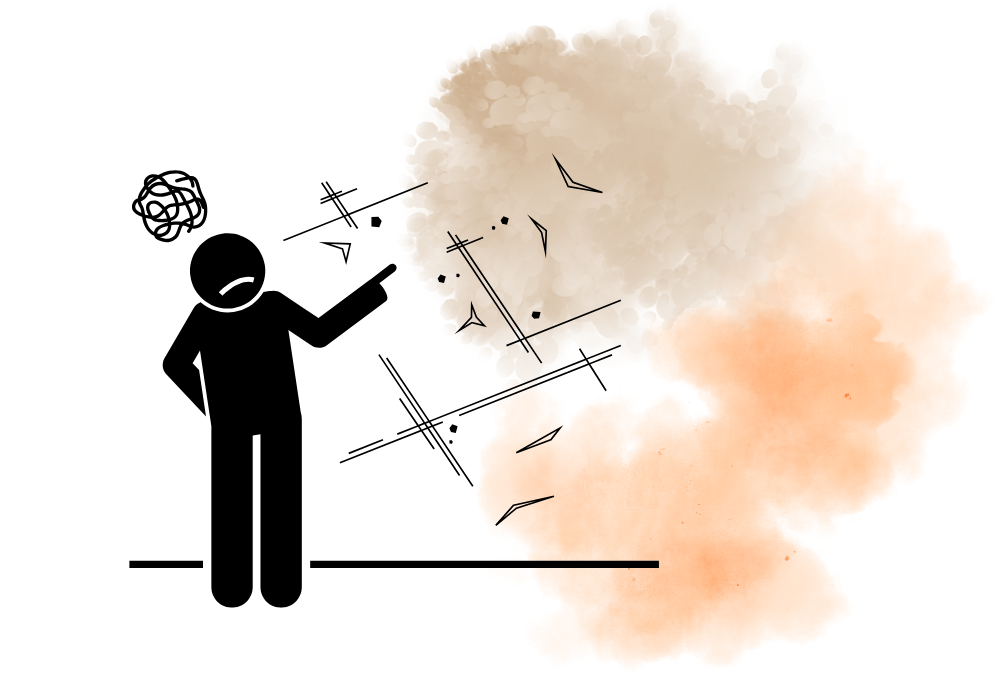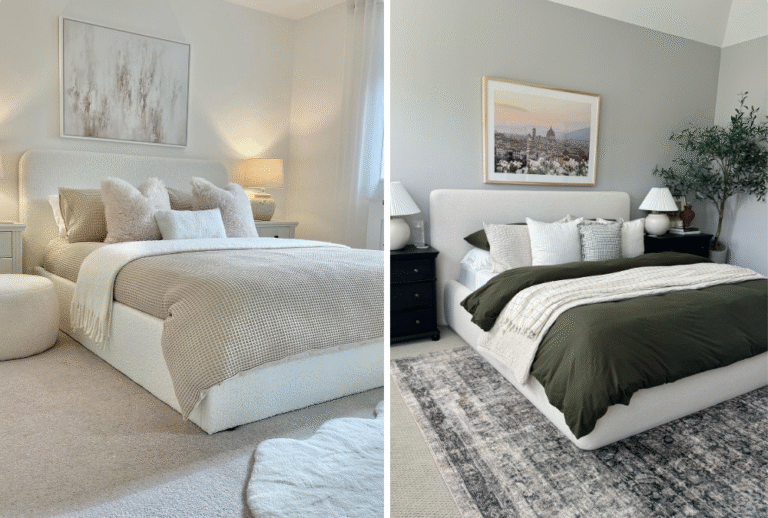How to Remove Wall Stains Without Removing Paint [Quick & Easy Tips]
Quick Answer: To remove wall stains without repainting, gently wipe the wall with a microfiber cloth and a mix of warm water and mild dish soap. For tougher stains, use baking soda paste or vinegar solution. Always spot-test first and avoid abrasive scrubbers to prevent paint damage.
Now let’s look at the details
You do not always need to repaint your walls when they get dirty. Many stains like crayon, grease or scuff marks can be cleaned with simple things like soap, baking soda or a soft cloth.
In this post, you will learn easy ways to clean different wall stains without using paint. These tips are safe, quick and work well on most painted walls. Let’s find the best way to make your walls look clean again.
Start Here: What Kind of Wall Do You Have?
Before scrubbing anything, check what type of paint or finish your wall has. Some surfaces are delicate and can’t handle strong cleaners.
Here’s a quick guide to help you match your cleaning method to your wall type:
| Wall Type | Cleaning Tip |
|---|---|
| Flat / Matte Paint | Use a soft touch as this finish is delicate |
| Eggshell / Satin | Clean gently using mild soap and a sponge |
| Semi-Gloss / Glossy | This surface allows light scrubbing without damage |
| Wallpaper | Always spot test first and avoid using too much water |
Tip: Always do a patch test in a hidden spot before using any solution.
👉 Related: How to Get Rid of Kitchen Ants Naturally
Cleaning Supplies You’ll Need
You don’t need fancy tools. Most stain removers are already in your home:
- Soft sponges or microfiber cloths
- Warm water
- Dish soap
- White vinegar
- Baking soda
- Magic eraser (optional)
- Spray bottle
- Old toothbrush
Avoid using abrasive scrubbers or steel wool, they can scratch or peel paint.
Start With a Gentle Approach (Warm Water + Dish Soap)
Before trying anything stronger, begin with the simplest solution. Warm water mixed with a little dish soap can clean a surprising number of wall stains without affecting the paint. Just add a few drops of mild dish soap into a bowl of warm water and swirl it around.
Dip a soft cloth into the soapy water and gently rub the stained spot using circular motions. Don’t rush; a slow, gentle wipe often works better than scrubbing. Once you’ve lifted the stain, go over the area again with a clean damp cloth to remove any leftover soap. Then give it a few minutes to dry on its own.
This method is perfect for dealing with everyday marks like food splashes, general dust build-up, or light dirt patches that sneak up over time.
For Tougher Stains: Use Vinegar and Water
Grease and smoke stains need something stronger.
How to do it:
- Mix equal parts white vinegar and warm water.
- Spray the solution directly on the stain.
- Let it sit for 2–3 minutes.
- Wipe gently with a microfiber cloth.
- Rinse with plain water and dry.
Works best for:
- Kitchen grease
- Smoke residue
- Handprints around light switches
Crayon and Marker? Use Baking Soda Paste
If your kid has turned the wall into their personal canvas, you’re definitely not alone. Crayon and pencil marks might seem hard to remove, but there’s an easy fix hiding in your kitchen: baking soda. Just mix a spoonful of it with a tiny bit of water until it turns into a soft paste.
Gently rub the paste over the stained area using a soft sponge or cloth. You don’t need to press too hard, light circular motions usually do the trick. Once the mark begins to fade, wipe off the paste with a damp cloth. To finish, pat the wall dry with a clean towel.
This simple method works well on crayon scribbles, pencil lines, and even sticky smudges. But here’s a heads-up: baking soda is a little gritty, so be careful on matte or flat paint. Scrubbing too hard might dull the finish, so always go gentle and spot-test first if you’re unsure.
Magic Eraser for Scuff Marks and Shoe Prints
Some marks just won’t budge with soap or baking soda. If you see black scuffs from shoes or furniture, try using a melamine sponge, often called a Magic Eraser. It’s gentle but strong enough to lift tough stains without needing chemicals.
Wet the sponge with a little water and squeeze it until it’s damp. Then lightly rub the stained area in small circles. You don’t need to press hard. After the mark fades, wipe the area with a clean cloth and let it dry.
This method works really well on dark heel marks, furniture rubs, and dirty corners near the floor.
Toothpaste (Non-Gel) for Ink and Light Marker
You can use plain white toothpaste to clean some wall stains. It works well on light marker lines, ink spots, and sticky dirt near door frames.
Put a small amount of toothpaste on the stain. Then gently rub it with a soft cloth or an old toothbrush. Move in small circles and don’t press too hard. After that, use a damp cloth to wipe the area clean. Let it dry on its own.
This method is simple and safe for most painted walls.
Bathroom Mold? Use Hydrogen Peroxide Mix
Some stains get stuck deep in textured paint or wall corners. In these cases, steam can help loosen the dirt without any scrubbing. A small handheld steam cleaner is all you need for this job.
Fill the steamer and turn it on using a low setting. Hold the nozzle a few inches away from the wall and move it slowly over the stained spot. As the steam softens the grime, wipe it away with a clean microfiber cloth.
Steam cleaning works well on kitchen walls with grease build-up, bathroom corners with dried-on dirt, and hard-to-reach spots where scrubbing is tricky. Just avoid using steam on wallpaper or cracked paint, as it might cause damage.
What Not to Do
Sometimes trying too hard can actually cause damage. Here are a few things to avoid so you don’t make the problem worse.
Using too much water can soak into your paint or drywall and leave stains behind. It’s better to use a damp cloth, not a dripping one. Scrubbing too hard can also remove paint or leave rough patches, especially on flat or matte finishes. Take it slow and be gentle.
Never mix cleaning products. Mixing bleach with vinegar or other chemicals can create dangerous fumes. Always use one cleaner at a time and follow the label.
When to Call a Professional
If your wall has:
- Large water stains
- Fire or smoke damage
- Paint peeling or bubbling
… it might be time to call a painter or wall restoration expert. These stains may need more than a wipe-down.
Prevent Wall Stains in the First Place
Simple daily habits can keep your walls clean:
| Prevention Tip | Why It Helps |
|---|---|
| Use washable paint finishes | This makes wall stains easier to remove with water and soap |
| Install splash guards behind stoves | Helps block grease and food from hitting your walls |
| Set house rules (no shoes indoors) | Prevents dirt buildup and scuff marks from footwear |
| Wipe walls monthly with a damp cloth | Stops dust and grime before it becomes hard to remove |
How to Clean Wallpaper Without Peeling or Fading
Wallpaper is sensitive. Here’s the safe way to clean it:
Steps:
- Dust using a dry microfiber cloth or duster.
- Mix a few drops of dish soap in water.
- Dip a sponge and wring it out well damp, not wet.
- Gently wipe in downward strokes.
- Pat dry with a towel.
Avoid: Excess water, vinegar, and scrubbing these can cause bubbling or fading.
Oil-Based Stains? Try Cornstarch or Talcum Powder
If the wall stain feels oily or sticky, like from cooking oil, lotion, or hair spray, you can try a simple powder trick. Cornstarch or baby powder can help pull the oil out of the wall without damaging the paint.
Just sprinkle a small amount of powder right on the greasy spot. Let it sit there for about 15 to 30 minutes. This gives the powder time to soak up the oil. After that, gently brush it off or wipe it away with a soft cloth. If the stain is still there, you can repeat the process one more time.
When you’re done, clean the area with a damp cloth to remove any powder left behind. This works well on greasy fingerprints or lotion stains, especially around mirrors and dressing tables. If the stain is really strong, you can also spray a little vinegar and water mix afterward to finish the job.
Eco-Friendly and Kid-Safe Wall Cleaning Methods
If you have children, pets, or allergies, it’s best to avoid harsh cleaners.
Best Kid-Safe Wall Cleaners:
- Vinegar + water
- Baking soda + water paste
- Lemon juice (for mild stains)
- Unscented Castile soap diluted with water
What to Avoid:
- Strong chemical sprays
- Scented aerosol cleaners
- Bleach in non-ventilated spaces
Tip: Always read product labels. Even “green” cleaners may have hidden irritants.
Cleaning Textured Walls
Textured walls trap more dust and stains. Here’s how to handle them:
- Use a soft-bristle brush to remove dry dust first.
- Spray the wall with vinegar-water solution.
- Wipe with a damp microfiber cloth in circles.
- Use a toothbrush for grooves and patterns.
Bonus Tip: For brick or faux-texture walls, a vacuum with a brush attachment helps with deep cleaning.
What About Wallpaper?
Wallpaper can be delicate. Here’s how to clean it:
- Vinyl wallpaper: Use mild soap and water or vinegar.
- Textile wallpaper: Dry cloth only, or consult a pro.
- Peel-and-stick wallpaper: Use a damp cloth only, avoid soaking.
Don’t use: Baking soda or vinegar on non-vinyl wallpaper, it might discolor it.
How Often Should You Clean Walls?
Cleaning frequency depends on where you live and how busy your space is:
| Area | Quick Clean | Deep Clean |
|---|---|---|
| Kitchen | Weekly | Monthly |
| Bathroom | Weekly | Monthly |
| Living Room | Bi-weekly | Every 2 months |
| Kids’ Rooms | Bi-weekly | Monthly |
| Entryway | Weekly | Every 6–8 weeks |
Use phone reminders to stay on track.
Quick habit: Wipe down switch plates and wall corners during your weekly clean-up.
Wall Cleaning for Renters (No Paint Allowed)
If you’re renting, painting the walls might not be allowed. But you can still keep them looking fresh with gentle cleaning methods. Stick to soft cloths and mild cleaners like dish soap, vinegar, or Castile soap. These won’t damage paint or leave behind harsh smells.
Avoid strong scrubbers or magic erasers unless you’re sure the paint is thick enough. Some rental walls have thin coats of paint that can rub off easily.
A smart trick is to take before-and-after photos when cleaning tough stains. It can help show your landlord you took care of the place during move-out time.ections.
My Favorite DIY Wall Cleaning Spray (Natural + Cheap)
Here’s a natural spray I like to use for monthly cleanups. It’s gentle on paint and has a light, fresh scent.
Mix two cups of water with one tablespoon of white vinegar and one teaspoon of dish soap. If you want it to smell nice, add a few drops of lemon essential oil. Pour everything into a spray bottle and shake it gently.
Spray it directly on dirty spots and wipe with a soft microfiber cloth. It works great for fingerprints, food smudges, and general dirt buildup.
Frequently Asked Questions
Q: Can I use bleach to clean wall stains?
A: Only for mold or mildew, and always dilute it (1 part bleach to 3 parts water). Never mix bleach with vinegar or ammonia. Avoid using it on colored or matte paint, as it can cause fading.
Q: Will vinegar damage my wall paint?
A: Not usually, but always do a patch test first.
Q: What’s the safest method for rental walls?
A: Use mild dish soap and water. Avoid harsh scrubbing or chemicals. A damp microfiber cloth is usually enough for most marks.
Q: How often should I clean my walls?
A: Every 4 to 6 weeks is ideal. Spot-clean high-touch areas like hallways and around light switches weekly.
Q: Do magic erasers work on all walls?
A: They work well on glossy and semi-gloss walls but may dull flat paint. Always test in a hidden corner first.
Q: What if the stain won’t come off?
A: Try a second method (like baking soda or a magic eraser). If it still doesn’t work, consider covering the spot or repainting a small area.
Stains don’t always mean repainting. With basic household supplies and a little care, you can clean your walls without damage. Whether it’s grease, crayon, or mildew, there’s a method that works.
Bookmark this guide for your next wall-cleaning day and share it with friends who think paint is the only solution.
Extra Tip: Use Steam for Stubborn Build-Up
Steam can help loosen grime without damaging your paint.
How to do it:
- Use a handheld steam cleaner on a low setting.
- Keep it a few inches away from the wall.
- Move it slowly across the stained area.
- Wipe with a microfiber cloth.
Works best for:
- Kitchen walls with layers of grease
- Bathroom walls with mildew build-up
- Corners with hardened gunk
Warning: Don’t use steam on wallpaper or cracked paint.
Related: Best Colors for a Relaxing Bedroom





2 Comments